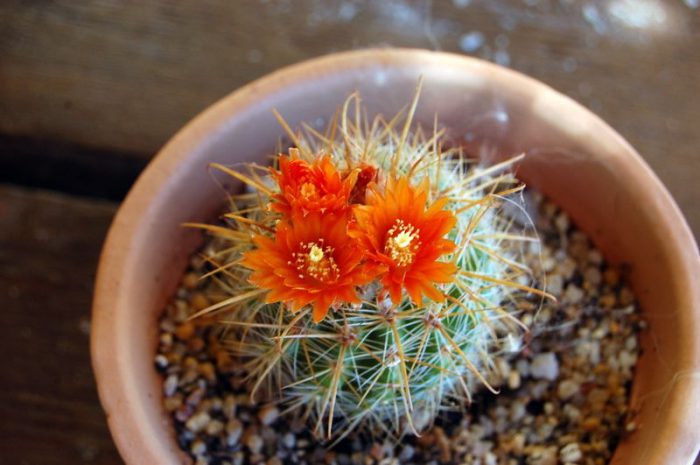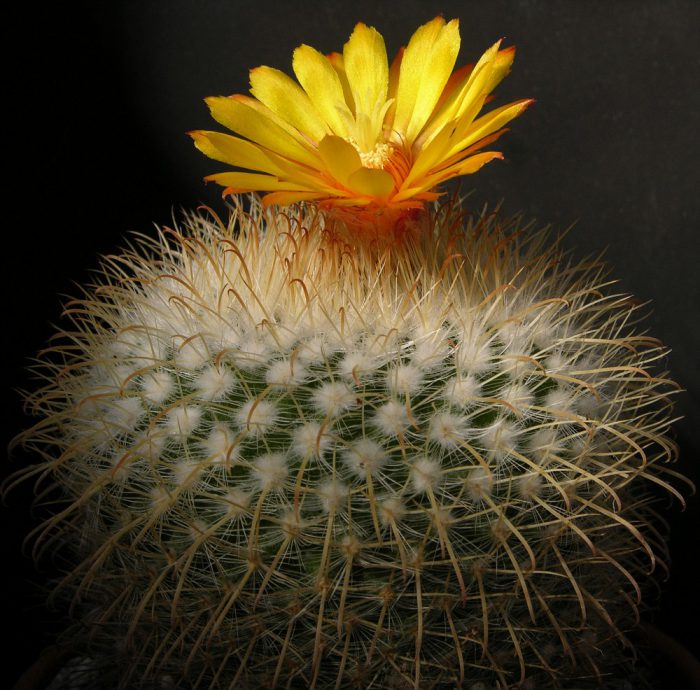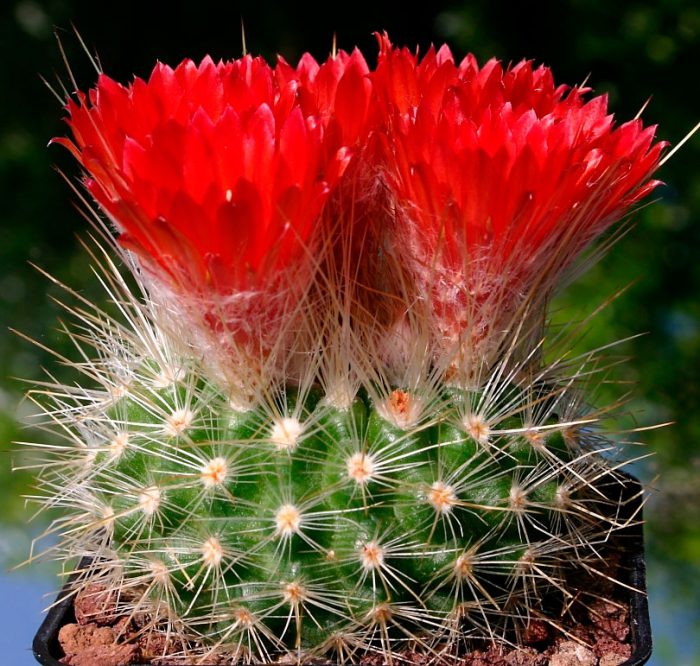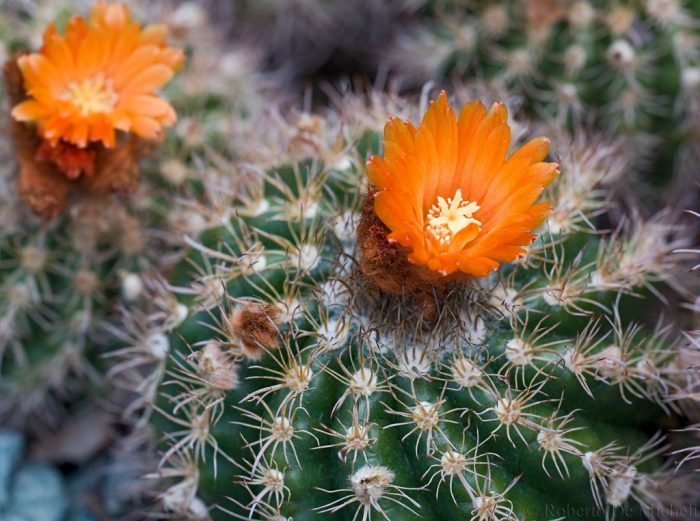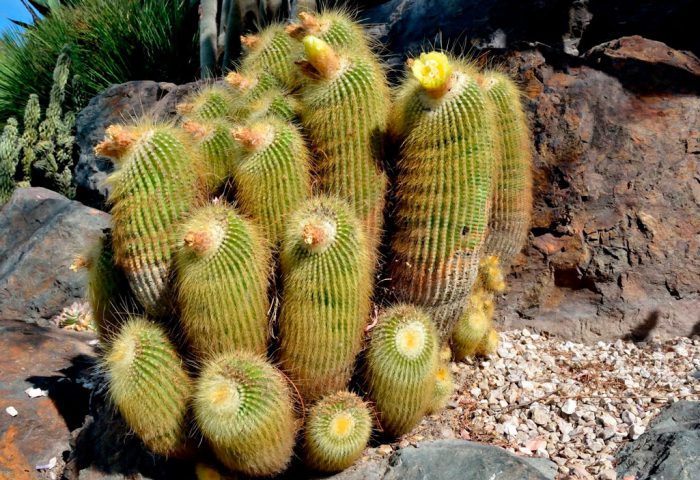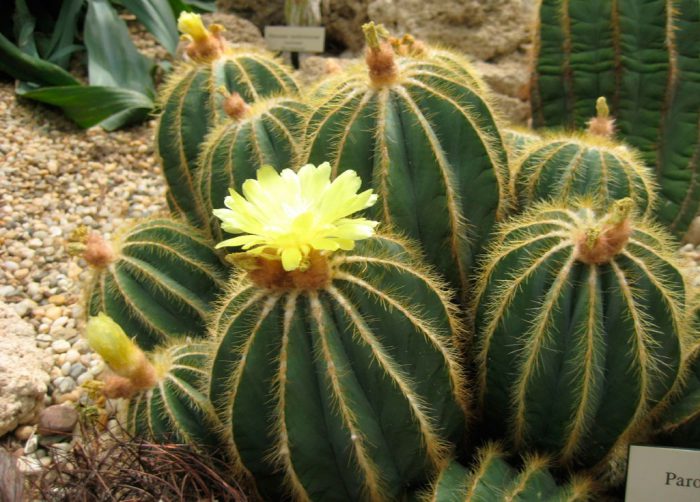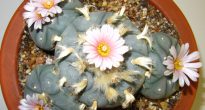Cactus parody (Parodia), which is also called eriocactus, is directly related to the cactaceae family (Cactaceae). This genus unites 50 species of various cacti. In nature, they can be found in Uruguay, Central and Southern Bolivia, Paraguay and Northern Argentina.
All of these species have a short stem in the form of a cylinder or a ball, on which well-visible spiral ribs are located. They have not very high tubercles with areoles with dense pubescence. From each areola comes from 1 to 5 central spines, reaching 4 centimeters in length, while it happens that one of them has a crooked tip, as well as 10–40 short spines - up to 0.5–1.5 centimeters long.
The plant begins to bloom at a young age. The multi-petal flowers, located in small groups in the upper part of the cactus, are funnel-shaped. Over time, fairly small dry fruits are formed. On the surface of both the fruit and the flower tubes, there is a layer of not very large spines and hairs.
Parody cactus care at home
This plant needs to be looked after in almost the same way as the rest of the cactus family. It is undemanding to care for and not capricious.
Illumination
Loves light and tolerates direct sunlight well. It is recommended to place this cactus on the sill of a south-facing window.
In autumn and winter, good lighting is needed, so the plant must be provided with additional lighting. So, the duration of daylight hours should be 10 hours. The abundance of future flowering depends on how good the illumination will be during this period.
Temperature regime
In the summer, it is desirable that the temperature be kept at 22 to 25 degrees. In the autumn-winter period, there is a dormant period, which begins in October or November, and ends in March. For this period, the cactus must be rearranged in a cool place from 10 to 12 degrees. It should be noted that the temperature in the room should not drop below 7 degrees, because in this case the plant may freeze and die.
The room where the cactus is located is recommended to be systematically ventilated.
How to water
During intensive growth, watering must be done regularly. Watering, as a rule, is carried out only after the top layer of the substrate is thoroughly dry.Overflow should not be allowed, since as a result of this, rot appears on the stem and roots, which can lead to the death of the parody.
In winter, with a cold content, watering the cactus should be several times less. However, the soil should not be allowed to lose its turgor.
Humidity
Feels great at low humidity in city apartments.
Earth mix
Suitable soil should be loose, nutrient-rich and water-permeable. To prepare the soil mixture yourself, it is necessary to combine sheet, sod and peat soil, brick chips (can be replaced with broken expanded clay) and coarse sand, which should be taken in equal proportions. You can buy ready-made cactus soil mix in a special store.
Be sure to create a good drainage layer to avoid stagnant moisture in the substrate.
Fertilizer
During intensive growth, top dressing is performed 2 times a month. To do this, use fertilizers intended for succulents and cacti, while taking only ½ part of the dose recommended on the package.
Transplant features
This cactus grows rather slowly, in this regard, its transplant is carried out only if necessary, for example, if a flower pot becomes small for it.
You can transplant it in the spring, before the period of intense growth begins, or in the fall, when flowering ends.
Reproduction methods
Reproduction of parody is difficult enough. Seed propagation is a long and difficult task. The fact is that the growth of seedlings is very slow, but they can easily die from the fact that green algae begin to grow on the soil surface. It will be possible to propagate this plant with children only in rare cases, because most species may not produce them for many years.
Pests
Red can settle on a cactus spider mite... If this happens, then it will be necessary to carry out the treatment with Aktellik or another chemical agent of a similar effect.
Main types
Many types of parody cactus can be grown at home.
Parody golden prickly (Parodia aureispina)
This type is most popular among flower growers, as it has a very spectacular appearance. A not very large spherical stem, painted green, in an adult plant reaches no more than 6 centimeters in width. It has yellow-golden thorns. So, there are 6 central rather long spines, and 40 bristle-shaped thin radial spines. There is a hook at the tip of one of the strongest central spines, which is 15 millimeters long. The flowers have a small diameter of only 3 centimeters (when opened), and they are colored yellow-golden.
Parody of golden-needle (Parodia chrysacanthion)
This species is very similar to the parody of golden prickly, but an adult specimen, having a stem in the shape of a ball, reaches 10 centimeters in diameter. And there are no hooks on the central spines.
Parody snow (Parodia nivosa)
A young plant has a spherical stem, but over the years it stretches. So, in adult specimens, its length is 15 centimeters, and its width is 8 centimeters. Areoles have whitish pubescence, as well as 4 gray central spines 2 centimeters long and 15-40 radial snow-white spines 0.2 centimeters long. The fiery red flowers have a diameter of 5 centimeters.
Parody Schwebs (Parodia schwebsiana)
The spherical stem in an adult specimen is 11 centimeters wide and 14 centimeters long. Such a cactus is distinguished by the pubescence of areoles. So, the closer the areola is located to the top of the stem, the thicker its pubescence. At the top of the plant there is a whitish "cap" consisting of many areoles. The pale brown spines are large enough. The 4 central spines are 2 centimeters long, and the 10 radial spines are 1 centimeter long. The darkest and thickest central spine is slightly curved at the tip, which forms a small hook.
Parody Leninghaus (Parodia leninghausii)
There is a rather long cylindrical stem, which reaches 60 centimeters long and 15 centimeters wide. From each areola emerge from 15 to 20 thin yellowish radial spines of a centimeter long and 4 thicker and longer (5 centimeters) central spines. The whitish-yellow flowers have a diameter equal to 6 centimeters. This cactus most often grows in groups, while the overgrown fluffy columns have different sizes, which gives the plant a funny look.
Parody magnificent (Parodia magnifica)
The green-blue stem has the shape of a ball, which in an adult specimen reaches 15 centimeters in length. It has 11-15 sharp, straight, deeply cut ribs. The yellow-golden bristle spines are not divided into radial and central ones, and their length is approximately 2 centimeters. Light yellow flowers have rather wide petals, which are arranged in 2 rows. When unfolded, the diameter of the flower is 4.5 centimeters.


